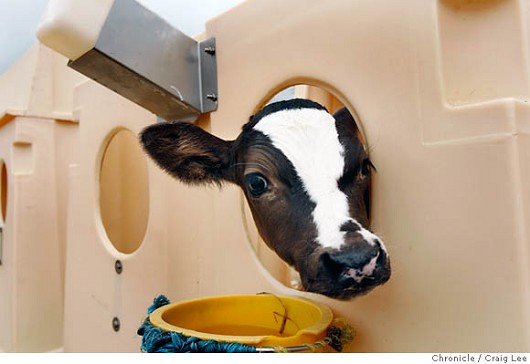The Faces of Organic/Clover Stornetta Farms
The Faces of Organic/Clover Stornetta: Leading dairy farmers to greener pastures
Carol Ness, Chronicle Staff Writer

Calves spend up to their first two months in condos to keep them from infecting one another at St. Anthony's Farm, a Clover Stornetta supplier. Chronicle photo by Craig Lee
Standing thigh-deep in pasture grass last week, Camozzi lets a friendly
But he did things the way his father had, and his grand-father and great-grandfather, out in
Clover talked him into it, pointing out that most of what he did already met organic requirements -- and that while his cows wouldn't produce quite as much milk, each gallon would earn him a lot more money. Conventional milk prices had tanked anyway, and dairymen were going broke.
So Camozzi took the leap in 2002.
"When we first started, everyone thought we were crazy," Camozzi says, meaning his fellow dairymen. "But the public loves the idea."
Payoff comes slowly
The financial rewards took a while to kick in -- it's slowly starting to pay off. But other benefits were immediately clear.
"The animals are definitely healthier," he says. Breeding problems disappeared. And he feels the milk is better.
"That's success to me," he says.
Clover Stornetta Farms and the smaller Straus Family Creamery in West Marin are surfing organic milk's recent wave of popularity. They're both family owned companies that work to distinguish themselves from mass producers by stressing quality.
"We have 19 family farms in Marin,
"Everyone in the country buys from co-ops. They have no idea where that milk comes from," says Benedetti.
Organic milk sales, which are growing 20 percent a year, now account for 10 percent of Clover Stornetta's sales.
"We struggled to reach 1 or 2 percent, then two years ago started seeing major shifts," he says.
When the
The company stopped buying milk from the California Cooperative Creamery, picked dairy farms producing the cleanest milk to put under contract, and worked with the farms to make changes. Their farms earned humane certification, went growth-hormone-free and fenced off streams to keep cows from polluting the watershed.
The first farm they took organic was St. Anthony's 339-acre spread, out past
Prevention is key
Prevention is a big part of what goes on at St. Anthony's, or any organic dairy, where antibiotics routinely used in conventional dairies are forbidden.
The first thing you see when you get to St. Anthony's are the "calf condos," dozens of tan plastic boxes like dog crates lined up outside the barn. The tops flip open on sunny days; the calves have room to turn around and lie down in the straw bedding.
Calves are like children -- they get sick a lot. To keep them from infecting one another, St. Anthony's calves spend their first one or two months in the hutches, sticking their double-tagged heads out round holes as visitors approach. They suck hungrily on milk in plastic bottles with 5-inch nipples -- or a visitor's fingers.
Slightly older calves move into an open-sided shed, six to a roomy pen with lots of clean straw. A conventional farm would have up to 15 youngsters in each pen, says farm manager Jim Hogue, who worked on a big one. And the straw would be full of manure, he says.
In one pen, a young
"That one has a cold," Hogue says. The last thing he wants is an infection running through the herd. Aspirin, homeopathy and monthly vaccinations should get the cow through.
"But we're not going to let a cow suffer," Hogue says. "We'll use antibiotics if we have to." But treated cows can never be considered organic again and are sold off to conventional farms.
Older cows head outside to pasture, or their large "loafing barn," depending on the weather -- the cows like to lounge under cover when it's rainy or too hot, waiting for their twice-daily milking. Every animal has a stall, bedded with almond shells, rice hulls and ground oyster shells, that's cleaned twice a day.
More farms in transition
Four of Clover Stornetta's 19 farms are now organic, and five more are in transition, according to Benedetti.
The challenge for them is keeping their price competitive with organic milk from huge confinement dairies operating in the Central Valley,
So far, organic is working for Clover. Overall sales hit $95 million last year, up 5 percent from the year before.
Continuing success depends on organic milk continuing to command a higher price, says Benedetti, whose son and daughter now help run the business.
"If the USDA allows factory farms to continue and grow, we'll see Wal-Mart expose the nation to organic milk at cheaper prices," he says.
"The big question is, at what cost?"
E-mail Carol Ness at cness@sfchronicle.com.



